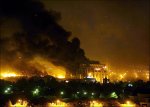Home > English > Politics > Depleted uranium used once more in Iraq
 Depleted uranium used once more in Iraq
Depleted uranium used once more in Iraq
Friday 12 December 2003, by
The British Atomic Energy Authority had concluded in a report given to the government in 1990, before the First Gulf War, that every ton of depleted uranium (DU) left in a given area could foster about a thousand cancers.
It has been estimated in fact that 900 tons of DU dust has been spreading well beyond the area it was initially used in combat- that is the Saudi- Iraqi bordering regions, Kuwait, Baghdad and southern Iraq, which recieved more bombs in six weeks than the entire planet during the second world war. I’ll let you do the math.
DU is the waste created during the enrichment process of Uranium. For every ton of enriched uranium produced, there is roughly about 7 tons of DU created. It is estimated that over 700, 000 tonnes of DU are stored in the US, which partly led to its military use by the US Army. DU has been tested since the 1960s because of the many military advantages it offered, as well as the fact that it was a costless by-product of uranium enrichment processing.
DU has been used for civilian purposes, such as in airplanes, despite the fact that it can ignite independently, and that it quickly destroys metal, creating this fine dust and chips which can be obviously inhaled.
It was apparently used the first time in Iraq in 1991. At the time, Saddam’s control over Iraq seems to have been so total and complete that the US-led coalition did not find it so difficult to convince the international community that Iraq was the Ba’ath leader’s personal arsenal of "Weapons of Mass Destruction".
Saddam indeed did not recognise the individual existence of an Iraqi, stripped him of any real identity except that of a productive unit, a loyal subject and cannon fodder. But the Allied Forces understood quite early how useful and necessary it was to play Saddam’s game of dismissing any value an Iraqi life might possible have.
Why? It suited the methods they used to successfully achieve their goals, which were at the time to destroy Iraq’s capacity under Saddam Hussein to become the major military and economic powerhouse in the Middle east. After all, the US-led coalition in 1991 chose deliberately not to invade Iraq, letting the Iraqi uprisings against the Saddam regime they had promised to support at the mercy of Baghdad’s brutal repression. The Iraqis have obviously not forgotten this betrayal.
As heated controversy arose since the late 1990s, with recent reports that over 1, 400, 000 Iraqis had died because of UN embargo sanctions alone, including 560, 000 children, Madeleine Albright had apparently answered "This is a very hard choice" (To continue the UN embargo), but the price, we think, is worth it."
Today, as the second Gulf War, the one of occupation, rages on into 2004, a new issue has been raised: What exactly is worth, in Albright’s terms, the continued use of DU in bullet coats in Iraq since March 2003?
The main answer might be that it supposedly pierces armor, and US officials have justified its use because of its "low" radioactivity. In fact, the Pentagon did not want to publicize the use of DU too much, as it was already aware of the health hazard it constituted.
However, US veterans who have organized their protest, have been denied any form of reparation, apologies, or even a recognition that the DU radioactivity constitutes a true threat. Moreover, militant’s homes have been broken into; disks, files, reports were stolen.
DU has been in continued use since 1991, and was used in the 1999 NATO bombing of Serbia. High levels of radioctivity (40 times the normal level) were reported in Bulgaria, Hungary and Greece, which can only suggest again that DU dust likes to travel.
In Iraq, residues of DU have been found near residential areas, in wastelands left by the war where chidren frequently go to play. Many areas have been restricted by the US occupation army, with warning signs in Arabic. Moreover, the airproof suits the Marines wore during the invasion in 2003 was officially to prevent exposure from Saddam’s Weapons of Mass Destruction. But these suits were in fact necessary to prevent Allied exposure to their own army’s chemitoxic and radiotoxic weaponry.
The US have introduced a terrifyingly cheap and accessible kind of radioactive warfare on the international scene. Ever since the Atomic bomb in 1945, the US have had this habit. The only problem is that DU can be easily obtained to fabricate the dreaded dirty bombs.
The Laka Foundation Report, September 1999. It includes tables classifying the reported effects of DU on humans, animals and food, as well as the different types of diseases that were reportedly contracted by Allied and Iraqi veterans and the Iraqi civilians.
Depleted Uranium: A Post-War Disaster for Environment and Health